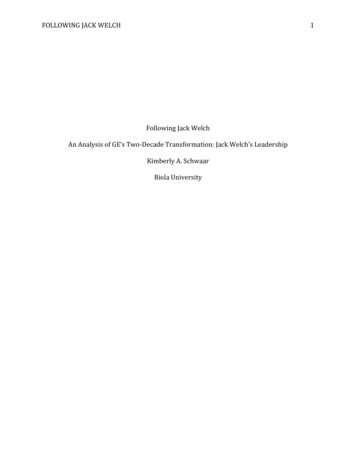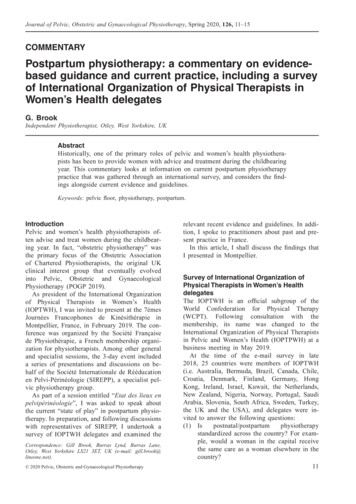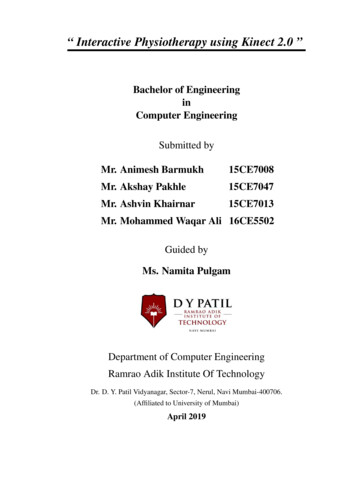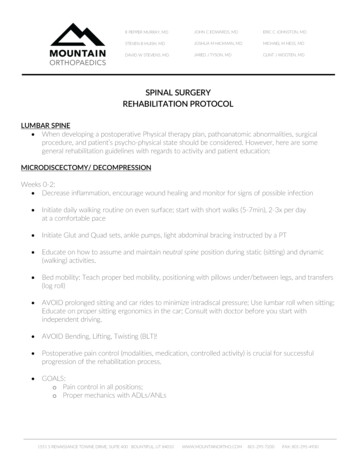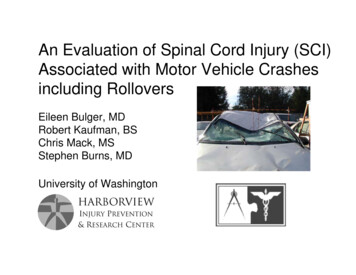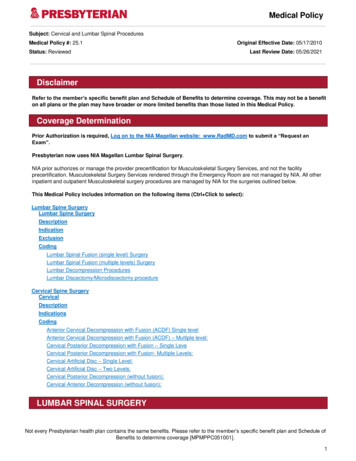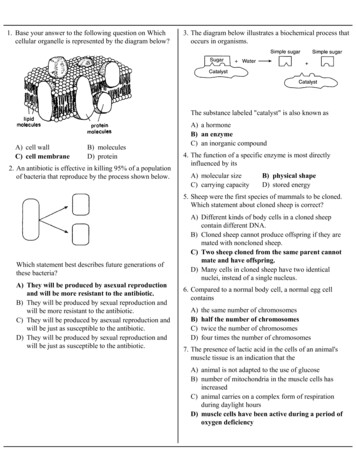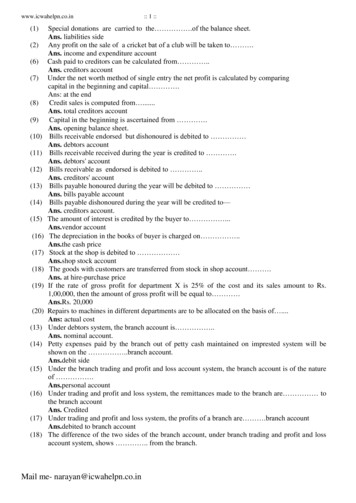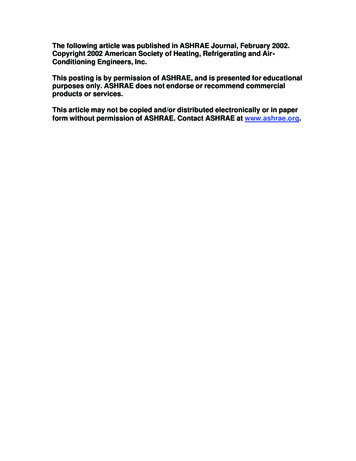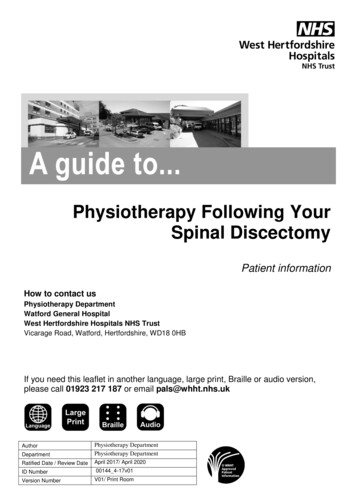
Transcription
Physiotherapy Following YourSpinal DiscectomyPatient informationHow to contact usPhysiotherapy DepartmentWatford General HospitalWest Hertfordshire Hospitals NHS TrustVicarage Road, Watford, Hertfordshire, WD18 0HBIf you need this leaflet in another language, large print, Braille or audio version,please call 01923 217 187 or email pals@whht.nhs.ukDepartmentPhysiotherapy DepartmentPhysiotherapy DepartmentRatified Date / Review DateApril 2017/ April 2020ID Number00144 4-17v01Version NumberV01/ Print RoomAuthor
What is a lumbar discectomy?A lumbar discectomy is an operation performed to trim an out of place piece of disc and relieve thepressure it is placing on the nerves in your spine. The pressure from the displaced disc can causeyou to have pain which may spread into 1 or both of your legs and also cause weakness.How long will I be in hospital?The average length of stay following a lumbar discectomy is between 1-2 days; however this isdependent on your previous level of fitness and any medical or post-operative complications. If youare motivated you may be able to get home sooner. You will only be discharged when the team ishappy.IntroductionWhilst supervised physiotherapy is important, it should be remembered that physiotherapists canonly guide the rehabilitation, they cannot do the exercises for you. Good motivation and mentalattitude is a key component to rapid recovery and you have a very important contribution to maketo the success of your surgery.The programme for recovery that is outlined below should be regarded as a guideline – patientsare individual and each have a different pace and rate of recovery.SurgeryThe aim of surgery is primarily to relieve leg symptoms. Some ongoing low back ache is notunusual; post-operative physiotherapy will improve this.Some people come round from the anaesthetic and feel immediate relief of their leg symptoms.Pain often settles fairly quickly.Numbness and tingling sensations usually take longer to settle though – this may be days, weeksor months. It varies considerably from person to person. Some people may always have an area ofnumbness that never fully recovers.Do not worry if your leg pain is still present – it is not a sign the surgery has failed. Nerves take along time to recover from being squashed. Bruising and swelling will be present which will settle,but can also irritate the delicate nerve tissue initially. However, please do report any ongoing ornew leg pain following your surgery to the staff on the ward or our enhanced recovery nurse uponyour return home.2
Getting in and out of bed Lyingon your back with your knees bent Reachover with your arm and let your knees lower to the bed Loweryour legs over the edge of the bed and push your trunk uTransversus abdominis (TA)The transverses abdominis muscle (TA) is the deepest of the abdominal muscles and is one of themain stabilisers of the lower back and pelvis. The orientation of the muscle is similar to a corset,whereby it wraps around your lower abdomen and attaches to your lower back. When the musclecontracts it acts like a back brace stabilising your spine and supporting your lower back.However, we would not recommend using a lumbar brace / support or belt. Research has proventhis to have a detrimental effect and actually weaken the core muscles.To activate your TA Lying on your back with your knees bent up and feet flat on the bed. Slowly draw your belly button down and inwards (away from your belt line). Breathe normally. Do not hold your breath.Your rib cage should remain relaxed and should not lift up during this process. You should be able to feel the muscle contracting.Gently hold this muscle at 20 – 30% of a maximum contraction. Do not brace / tense therest of your body.3
NOTE: Ideally, you should learn to activate your TA muscle during all activities of dailyliving.Pelvic floor (PF)The PF muscles are the muscles located between your legs and run from your pubic bone at thefront, to the base of the spine at the back. As their name suggests, they form the floor of thepelvis. They are shaped like a sling holding your pelvic organs (bladder and bowel) in place. Thepelvic floor muscles form an integral part of your spinal support musculature and as such, it isimportant to maintain the strength in these muscles.To activate your PFCorrect technique is very important when doing PF muscle exercises. You should feel a distinct ‘liftand a squeeze' inside your pelvis. The lower abdomen may flatten slightly, but try to keepeverything above the belly button relaxed and breathe normally.It is important to remember that this is a “secret exercise”, as only the PF muscles should beworking; this is an exercise that no one can see you performing!When learning how to activate the PF men and women often find different teaching methodsbeneficial: Lie on your back with your knees bent up and feet flat on the bedFemalesSqueeze and draw in the muscles around your vagina and back passage together – as if stoppingyourself from passing urine and wind at the same time. You should feel the distinct lift andsqueeze of your PF, as if closing and zipping up your back and front passages.MalesSqueeze and draw in the muscles around your urine tube and back passage together - as ifstopping yourself from passing urine and wind at the same time. You should feel the distinct liftand squeeze of your scrotum upwards. Breathe normally and gently hold this muscle contraction at 20 – 30% of a maximumcontraction. Hold for 5–10 seconds. Repeat 10 times Once you have mastered the technique you can also perform in sitting and standingPost-operative exercisesPerform these exercises 3 times a day: Laying on your back, squeeze your buttocks firmly together. Hold for 5-10 seconds. Repeat10 times.4
Laying on your back, engage your pelvic floor (PF) and Transversus abdominis (TA)muscles bend and straighten your legs alternately. Repeat 10 times. Laying on your back, engage your PF and TA muscles, pull your toes towards you andtighten your thigh muscle, straightening your knee. Hold for 5-10 seconds. Repeat 10 times.AdviceFor the first 4 weeks, whilst the initial post-operative pain settles and the disc begins to heal, it isadvised to be careful with some activities. A sensible approach is advised and a gradual pacedincrease in activities is recommended, bearing in mind post-operative discomfort and previouslevel of function.Sitting: Should be gradually built up during activities such as eating or relaxing and should beguided by your symptoms. A limit of 20 minutes at any one time is sensible for the first few days.Once this is comfortable it can be gradually increased. If a long journey is unavoidable (travellinghome), you can recline your seat and take a break every 20-30 minutes to mobilise.Avoid: prolonged sitting (for more than one hour) for about 4-6 weeks until neural sensitivity hassettled.Caution: with prolonged standing for the first 4-6 weeks.Caution: with flexion in sitting and standing for the first 4-6 weeks.Walking: is advised and should be increased daily as comfort allows.Lifting: for the first week should initially be limited to about 1 kg (a half full kettle), then graduallyincreased. Avoid heavy lifting greater than 10kg until 12 weeks after your surgery.Ideally heavy lifting and any prolonged activity (sitting or standing) should be avoided for 12 weekspost operatively due to the risk of recurrent disc prolapsed. This risk is at its highest in the first 12weeks.5
Outpatient physiotherapyYour physiotherapist will refer for you outpatient physiotherapy. Outpatient Physiotherapy can bearranged at Watford General,Hemel Hempstead or St Albans City HospitalsPlease liaise with your physiotherapist, if one of these hospitals is not local to you, or if you areunable to travel.Return to workAs a guide, you are likely to need about 6 weeks off work.If you do a sedentary (mainly sitting down) job you may be back at your desk after about 6 weeksas long as you are able to stand and move around regularly. If you do a more manual job, it maybe around 12 weeks.N.B: Ideally a phased return to work is bestDrivingPlease check your car insurance policy. It is recommended that you avoid driving for 3-4 weeks asthis can aggravate your leg pain. When you do start, please ensure you can perform anemergency stop, safely without pain.SportsGentle low impact and non-contact sports can start at 6 weeks, e.g. swimming and cycling (notbreaststroke).High impact and contact sports should be avoided until 4 to 6 months.Your individual physiotherapist can give you specific guidance and advice on return to yourpreferred / chosen sport.Recovery from this surgery can take up to 3 months but will continue up until 18 months6
only guide the rehabilitation, they cannot do the exercises for you. Good motivation and mental attitude is a key component to rapid recovery and you have a very important contribution to make to the success of your surgery. The programme for recovery that is outlined below should be regarded as
